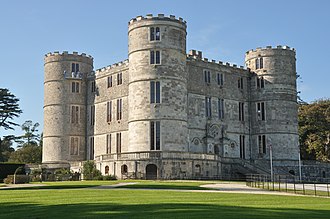Lulworth Castle

Lulworth Castle, located in Dorset, England, is a 17th-century mock castle that has played a significant role in British history. The castle was originally built as a hunting lodge in 1608 by Thomas Howard, 3rd Viscount Howard of Bindon, a member of the powerful Howard family. Over the centuries, Lulworth Castle has undergone numerous transformations and has witnessed a wide range of historical events, making it a fascinating subject for historians and tourists alike.
History[edit]
The construction of Lulworth Castle began in the early 17th century as a hunting lodge for Thomas Howard. Its design was unique for the time, featuring a rectangular structure with four circular towers at each corner, which gave it the appearance of a castle. Despite its defensive appearance, the castle was never intended for military use. It served as a luxurious residence where the Howard family could entertain guests and enjoy hunting in the surrounding countryside.
In the 18th century, the castle became the property of the Weld family, who are still the owners today. The Weld family made significant modifications to the castle, including the addition of a Roman Catholic chapel following the Catholic Emancipation Act in the 19th century. This chapel is one of the earliest post-Reformation Catholic chapels in England.
The castle suffered a devastating fire in 1929, which left it in ruins. The roof and interior were destroyed, but the external walls remained standing. In the late 20th century, a major restoration project was undertaken to stabilize the structure and restore the exterior to its former glory. The castle is now open to the public, offering a glimpse into England's architectural and social history.
Architecture[edit]
The architecture of Lulworth Castle is a blend of medieval and early modern styles. Its mock castle design was innovative for its time, combining the aesthetic elements of a medieval castle with the comfort and luxury of a country house. The four towers provide a commanding view of the surrounding countryside, while the interior once featured lavish decorations and furnishings suitable for the noble Howard family.
Present Day[edit]
Today, Lulworth Castle is a popular tourist attraction. Visitors can explore the castle grounds, enjoy exhibitions detailing the history of the castle and the Weld family, and participate in various events held throughout the year. The castle also hosts weddings and other private functions, making use of its stunning architecture and picturesque setting.
Significance[edit]
Lulworth Castle is significant not only for its architectural beauty but also for its historical importance. It reflects the social and political changes in England from the 17th century onwards, including the fluctuating fortunes of the Catholic faith in the country. The castle's survival and restoration demonstrate the enduring appeal of historical buildings and the efforts made to preserve them for future generations.
| This article is a stub. You can help WikiMD by registering to expand it. |
Ad. Transform your life with W8MD's Budget GLP-1 injections from $75


W8MD offers a medical weight loss program to lose weight in Philadelphia. Our physician-supervised medical weight loss provides:
- Weight loss injections in NYC (generic and brand names):
- Zepbound / Mounjaro, Wegovy / Ozempic, Saxenda
- Most insurances accepted or discounted self-pay rates. We will obtain insurance prior authorizations if needed.
- Generic GLP1 weight loss injections from $75 for the starting dose.
- Also offer prescription weight loss medications including Phentermine, Qsymia, Diethylpropion, Contrave etc.
NYC weight loss doctor appointmentsNYC weight loss doctor appointments
Start your NYC weight loss journey today at our NYC medical weight loss and Philadelphia medical weight loss clinics.
- Call 718-946-5500 to lose weight in NYC or for medical weight loss in Philadelphia 215-676-2334.
- Tags:NYC medical weight loss, Philadelphia lose weight Zepbound NYC, Budget GLP1 weight loss injections, Wegovy Philadelphia, Wegovy NYC, Philadelphia medical weight loss, Brookly weight loss and Wegovy NYC
|
WikiMD's Wellness Encyclopedia |
| Let Food Be Thy Medicine Medicine Thy Food - Hippocrates |
Medical Disclaimer: WikiMD is not a substitute for professional medical advice. The information on WikiMD is provided as an information resource only, may be incorrect, outdated or misleading, and is not to be used or relied on for any diagnostic or treatment purposes. Please consult your health care provider before making any healthcare decisions or for guidance about a specific medical condition. WikiMD expressly disclaims responsibility, and shall have no liability, for any damages, loss, injury, or liability whatsoever suffered as a result of your reliance on the information contained in this site. By visiting this site you agree to the foregoing terms and conditions, which may from time to time be changed or supplemented by WikiMD. If you do not agree to the foregoing terms and conditions, you should not enter or use this site. See full disclaimer.
Credits:Most images are courtesy of Wikimedia commons, and templates, categories Wikipedia, licensed under CC BY SA or similar.
Translate this page: - East Asian
中文,
日本,
한국어,
South Asian
हिन्दी,
தமிழ்,
తెలుగు,
Urdu,
ಕನ್ನಡ,
Southeast Asian
Indonesian,
Vietnamese,
Thai,
မြန်မာဘာသာ,
বাংলা
European
español,
Deutsch,
français,
Greek,
português do Brasil,
polski,
română,
русский,
Nederlands,
norsk,
svenska,
suomi,
Italian
Middle Eastern & African
عربى,
Turkish,
Persian,
Hebrew,
Afrikaans,
isiZulu,
Kiswahili,
Other
Bulgarian,
Hungarian,
Czech,
Swedish,
മലയാളം,
मराठी,
ਪੰਜਾਬੀ,
ગુજરાતી,
Portuguese,
Ukrainian